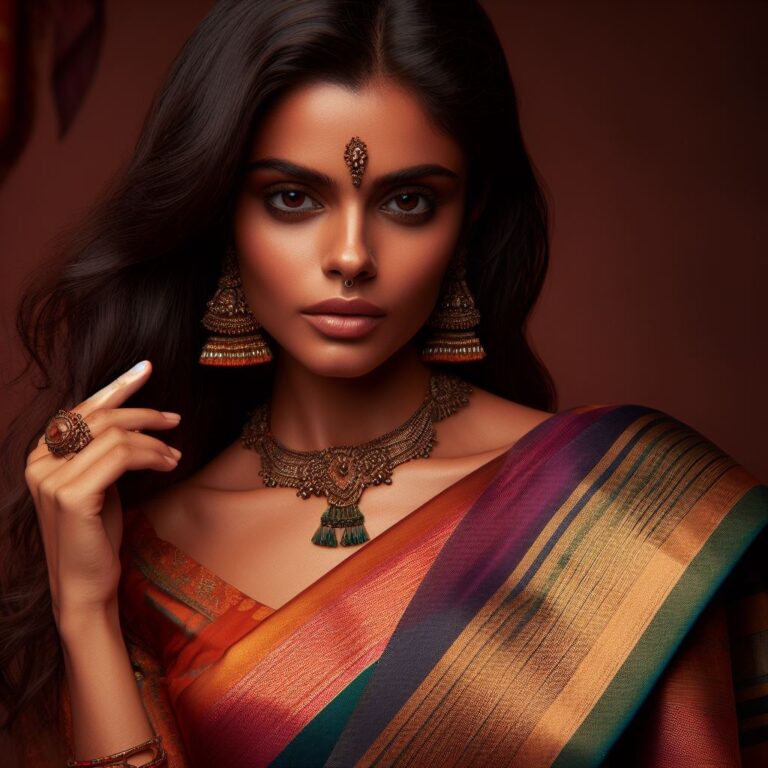Kanjivaram sarees, also known as Kanchipuram sarees, are an epitome of opulence, grace, and exquisite craftsmanship.
Originating from the town of Kanchipuram in Tamil Nadu, India, these sarees are celebrated for their rich silk, vibrant colors, and intricate gold zari work.
Kanjivaram weaving is a centuries-old tradition that has woven its way into the cultural heritage of South India.
In this article, we delve into the fascinating world of Kanjivaram weaving, exploring its history, techniques, unique features, and enduring appeal.
Table of Contents
Historical Roots
The roots of Kanjivaram weaving can be traced back to the ancient city of Kanchipuram, which has been a center of silk weaving for over 400 years.
According to legends, the sage Markanda, mentioned in Hindu mythology, is believed to have woven tissue from lotus fibers, inspiring the creation of the first silk saree in Kanchipuram.
Over the years, Kanjivaram sarees have become an integral part of South Indian weddings, festivals, and special occasions, symbolizing tradition, heritage, and unmatched craftsmanship.
Weaving Process
The creation of a Kanjivaram saree is a labor-intensive and intricate process that involves several stages of weaving:
- Silk Selection: The finest quality mulberry silk is used as the base material for Kanjivaram sarees. The silk threads are carefully selected for their smooth texture and durability.
- Dyeing: The silk threads are dyed in vibrant colors using natural or chemical dyes. Traditional colors like red, green, yellow, and royal blue are popular choices, representing various aspects of Indian culture and mythology.
- Zari Work: Zari, a thread made of fine silver or gold, is intricately woven into the fabric to create beautiful motifs and borders. The zari work adds a touch of grandeur and richness to the saree.
- Weaving: Kanjivaram sarees are woven on traditional handlooms. Skilled artisans meticulously interlace the dyed silk threads and zari, creating elaborate patterns and designs. The unique feature of Kanjivaram sarees is the contrast border and pallu (the loose end of the saree), which are woven separately and then attached to the body of the saree.
- Finishing: After the saree is woven, it undergoes a process of washing and polishing to enhance its luster and texture. The finished saree is a masterpiece of craftsmanship, showcasing the skill and expertise of the weavers.
Distinctive Features
Kanjivaram sarees are known for their distinctive features, which set them apart from other silk sarees:
- Heavy Silk: Kanjivaram sarees are woven with pure mulberry silk, making them heavy and luxurious to the touch. The weight of the silk adds to the drape and elegance of the saree.
- Contrast Borders: One of the most striking features of Kanjivaram sarees is the contrast border and pallu, which are woven in a different color or pattern than the body of the saree. This contrast enhances the visual appeal of the saree.
- Intricate Motifs: Kanjivaram sarees feature intricate motifs inspired by nature, mythology, temples, and traditional art forms. These motifs are woven with precision and attention to detail, adding to the artistic allure of the saree.
- Durability: Kanjivaram sarees are known for their durability and longevity. The high-quality silk and sturdy weaving techniques ensure that these sarees can be passed down through generations as treasured heirlooms.
Enduring Appeal
The timeless appeal of Kanjivaram sarees lies in their ability to blend tradition with contemporary elegance.
These sarees are not just garments; they are a symbol of cultural heritage and artistic finesse.
Kanjivaram sarees have transcended regional boundaries and are cherished by women across the world for their unmatched beauty and craftsmanship.
Kanjivaram weaving stands as a testament to the skill, creativity, and cultural richness of South India.
Each Kanjivaram saree tells a story of tradition, craftsmanship, and artistry, making it a cherished possession for every woman who wears it.
As the legacy of Kanjivaram weaving continues to thrive, it reinforces the significance of preserving and promoting traditional crafts, ensuring that the art of weaving continues to weave the fabric of India’s cultural heritage for generations to come.
FAQs about Kanjivaram Weaving
- What is Kanjivaram Weaving?
- Kanjivaram Weaving refers to the traditional handloom silk saree weaving craft originating from Kanchipuram, a town in Tamil Nadu, India. It is renowned for its rich silk, vibrant colors, and intricate zari work.
- What makes Kanjivaram sarees distinct from other silk sarees?
- Kanjivaram sarees are known for their heavy silk, contrasting borders, and pallu designs. The unique feature is the use of pure zari, often made of gold or silver, which adds a luxurious touch to the sarees.
- How is the silk used in Kanjivaram sarees sourced and processed?
- The silk used in Kanjivaram sarees comes from mulberry silk worms. The silk threads are meticulously handwoven, and the sarees are traditionally woven with three shuttles, creating a durable and lustrous fabric.
- What are the typical motifs and designs found in Kanjivaram sarees?
- Kanjivaram sarees often feature traditional motifs such as peacocks, elephants, flowers, and geometric patterns. The borders and pallu are adorned with intricate zari work, showcasing the skill and craftsmanship of the weavers.
- Who are the traditional artisans involved in Kanjivaram Weaving?
- Kanjivaram Weaving is a specialized craft carried out by skilled weavers in Kanchipuram and its surrounding regions. Many of these weavers come from families with a long-standing tradition in the art of silk weaving.
- Is Kanjivaram Weaving only limited to sarees, or are there other products produced?
- While sarees are the most popular product, Kanjivaram Weaving is also used to create other traditional garments like silk dhotis and silk fabrics for special occasions. The art form is primarily associated with festive and bridal wear.
- How long does it take to weave a Kanjivaram saree, and what is the process involved?
- Weaving a Kanjivaram saree is a time-consuming process that can take several weeks. The process involves preparing the silk threads, setting up the loom, weaving the body of the saree, adding borders and pallu, and finishing with zari work.
- Can authentic Kanjivaram sarees be purchased, and where can they be found?
- Authentic Kanjivaram sarees can be purchased from authorized showrooms, handloom cooperatives, and reputable online platforms. It’s essential to verify the authenticity and quality of the saree before making a purchase.
- How has modernization impacted Kanjivaram Weaving?
- While traditional techniques are still preserved, modernization has influenced the industry through the introduction of power looms and contemporary designs. However, efforts are made to balance innovation with the preservation of traditional craftsmanship.
- Is Kanjivaram Weaving a dying art form, or is there a resurgence of interest?
- Kanjivaram Weaving continues to thrive, with a renewed interest in traditional handloom products. The appreciation for handmade, sustainable textiles and the cultural significance of Kanjivaram sarees contribute to the enduring popularity of this weaving tradition.


0 Comments